Will Pfeifer's Blog, page 33
March 28, 2013
My favorite movies, circa 1985
I found an old (class assigned) high school journal a week or so ago, and amid all the typical teen angst and crudely scrawled comic strips, I discovered an entry dated Feb. 25, 1985 and titled, annoyingly enough, "ALL TIME BEST MOVIES SINCE THE DAWN OF MAN (in no particular order)."
In other words, long before this blog, long before the Internet... hell, long before I could type ... I was blathering on about movies in print. So, in the interest of full disclosure and to prove that my current taste in cinema wasn't with me since birth (to say nothing of high school), I offer up that original list, along with a few comments looking back ...
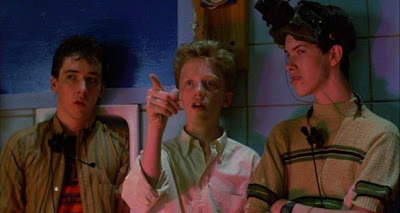
1. "Risky Business" (1983)
2. "Sixteen Candles" (1984)
3. "The Breakfast Club" (1985)
And thus, right off the bat, we establish this list was made by (a) a high school student in (b) the mid 1980s. So sue me. I was the perfect age for these movies when they hit theaters, and I responded to them as expected. I'd still argue "Risky Business" is a sharp, dark social satire with moments of mesmerizing cinematography and a great synth score by Tangerine Dream. And "Sixteen Candles" is still pretty solid, bits of inspired idiocy from Anthony Michael Hall. (The character of, ahem, Long Duk Dong, with its gong sound effects and pidgin English, is almost staggeringly appalling these days, though, and not just because I'm the father of a Chinese daughter. ) As for "The Breakfast Club," well, it definitely appealed to the 17-year-old me who figured that parents and/or other authority figures were the ones to blame for all the world's woes. Now, though, all the kids look like spoiled products of the Chicago suburbs, and Paul Gleason is the only one in the movie who makes any real sense.
4. "King Kong" (1933)
Loved it since before I saw it, back in the early days of my childhood when I was only reading about this classic in books about monster movies. It used to air every Thanksgiving on Channel 43 out of Cleveland, and I looked forward to it each year. Want to read more of my rambling thoughts on "King Kong"? Click here.
5. "Reefer Madness" (1936)
6. "Plan 9 From Outer Space" (1959)
And now, at long last, we see the developing cult movie fan begin to emerge. I'm not sure where I first saw these movies, but being that home video (that's VHS and Beta, youngsters, not Blu-ray or Netflix) was in its early days, I'm guessing it was a late showing on USA's "Night Flight." Either way, I'd read about both, probably in the Medved brothers' book "The Golden Turkey Awards." Nowadays, I hate that book's mocking attitude almost as much as I hate Michael Medved's politics, but I have to admit, it at least introduced me to the concept of a lot of great, offbeat movies. I still like both of these films, though I've come to see them as a sort of folk art (especially "Plan 9") rather than generic "bad" movies.
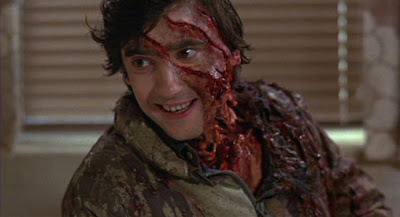
7. "An American Werewolf in London" (1981)
It wouldn't make my list these days, but there's no wonder it made it back in 1985: comedy, violence, amazing gore effects, some genuine scares, that crazy dream sequence with the Nazi zombies and, of course, a naked Jenny Agutter. Hell, maybe it should make my modern list after all ...
8. "Dr. Strangelove" (1964)
Allow me to pat myself on the back for having enough taste as a dimwitted teenager to appreciate one of the greatest movies of all time. Credit my dad, who filled shelves of pirated videotapes he duped with our old VCR, with introducing me to Stanley Kubrick's brilliant black comedy about the end of the world. Definitely on my current list, and depending on the day, the holder of the top spot.
9. "Psycho" (1960)
Probably my favorite Hitchcock, mostly for the sheer brilliant precision of the whole thing, and for the way the shower scene, by not playing fair at all with 1960 audiences, not only slices poor Marion Crane to pieces, it also cuts movie history apart, too. Plus, it's still pretty damned scary, no matter how much you've committed the entire movie to memory.
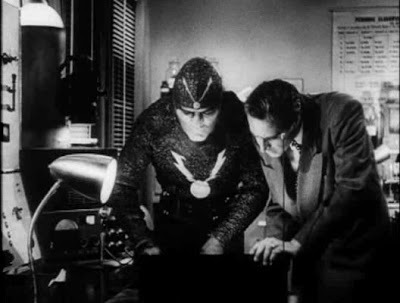
10. "J-Men Forever!" (1979)
Ever heard of this one? It's a genuine oddity from Phil Proctor and Peter Bergman of The Firesign Theatre comedy troupe. They (along with editor Gail Werbin) gathered footage from dozens of vintage movie serials, cut it together and redubbed the whole thing into a surprisingly sharp comedy about a super villain from the moon trying to conquer Earth with sex, drugs and rock 'n' roll. It's a good movie, don't get me wrong, but I'm betting the reason it made this list is I had just seen it a month or so earlier on USA's "Night Flight" and was eager to absorb every bit of counterculture humor it had to offer. Pretty soon I'd be exploring the even denser comedy of the Firesign Theatre albums and having them influence my own writing. Now, I own this on DVD, have those albums on CD and count Mr. Proctor among my Facebook friends. Crazy world, ain't it?
11. "Grave Robbers from Outer Space" (1984)
Hell, you didn't expect me to watch all those movies and not actually try making one of my own, did you? This half-hour, shot-on-VHS "horror" "film" stole its title from Ed Wood's "Plan 9 from Outer Space" but couldn't hope to be half as competent as that fondly remembered classic. My friends and I co-wrote, co-directed and co-starred, shooting it all in my hometown of Niles, Ohio. Locations included a cemetery, our church (both the minister's son and daughter had parts) and a local park, where we set a dummy on fire. It was great fun to make, but these days, I'm betting it would be great agony to actually watch.
12. "Little Shop of Horrors" (1960)
Another one that still has a shot on the all-time list. I've loved this Roger Corman black comedy since I first saw it as a kid on "Houlihan and Big Chuck," Cleveland's Friday night monster movie show, and my appreciation has only grown over the years. Sure, the talking plant's funny, and Mr. Mushnick's a gas, but what really gets me are the two sub-"Dragnet" cops who patrol Skid Row: "How's the wife, Frank?" "Not bad, Joe." "Glad to hear it. The kids?" "Lost one yesterday." "Lost one, huh? How'd that happen?" "Playing with matches." "Well, those're the breaks." "I guess so." (Click here to see how, not long after making this 1985 list, I put a fake obit in our local paper that was loaded with "Little Shop of Horror" jokes.)
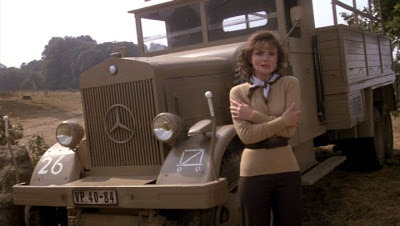
13. "Top Secret!" (1984)
Obviously, in hindsight, "Airplane!" is the Zucker-Abrams-Zucker movie that deserves a spot on a list like this, but "Top Secret!" was more fresh in my mind and plus, I was already developing that nagging film fan tendency to champion the lesser known movie, even if it isn't quite as good. This one's still pretty funny, with some wonderfully surreal side trips, and Val Kilmer (in his movie debut!) explodes out of the screen as singer Nick Rivers. I actually own the soundtrack LP (yes, LP) of this movie, which is only about 15 minutes long but well worth tracking down, if only for Kilmer's iconic performance of "Skeet Surfing." By the way, "Downton Abbey" fans, you'll want to rent this to see Jim Carter (aka Carson the butler) playing the dimwitted resistance fighter Deja Vu. ("Have we not met somewhere before?" he asks Nick.)
14. "Buckaroo Banzai (and His Adventures Across the Eighth Dimension" (1984)
Not a great movie by any means, but it's not hard to see why 17-year-old me loved it so much. It's so intent on being a cult film that only the sheer straining effort of its cultiness makes it miss the mark. I had a Banzai Institute T-shirt I wore for years in college (thus explaining my lack of dates) and read the movie novelization by Earl Mac Rauch several times. (It's actually a pretty good book, with a nicely modern take on pulp heroics and tons of material, including footnotes to previous adventures, not seen in the movie itself.)
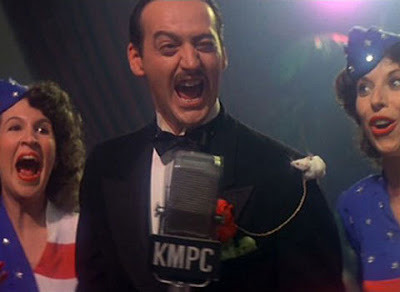
15. "1941" (1979)
I must've included this one to be deliberately perverse, right? I mean, it's a lot of fun and has a great cast (including SCTV favorite Joe Flaherty, above), but a spot on an all-time list? What was I thinking? And why did I leave other great comedies of the 1970s, like "Blazing Saddles" and "National Lampoon's Animal House," off the list completely. Because I was a 17-year-old idiot, that's why.
16. "Star Wars" (1977)
Of course. This was my all-time favorite movie from the moment I first saw that Imperial Cruiser zoom overhead back in the summer of 1977. There were times I never thought any movie could possibly knock it off the top spot, and I'm pretty sure that's how I felt even as late as 1985. Nowadays, as much as I fondly remember it, plenty of movies have passed it as favorites. Like, for instance, this next movie, made 44 years earlier...
17. "Duck Soup" (1933)
"Duck Soup" wasn't the first Marx brothers I saw. That was "Animal Crackers," which had aired on TV a few years before when some rights issues were straightened out. I've written before that my first glimpse of the Marxes was one of those moments when I could feel the ground shift under my feet. "Duck Soup," with its full-tilt, no-filler anarchy filling the screen, was the same only more so. What's really surprising, looking back, is that I fell in love with the movie without even seeing the whole thing. For years, the only copy I had access to was a copy from some TV station that was missing the first 10 or so minutes. And it still blew my fragile little mind.
So that's it. I have no idea why I decided to end that list on the nice, round number of, um, 17, but for some reason I stopped right there. Later in that same journal, I mentioned a few more movies I apparently hadn't seen as of Feb. 25, 1985, including "Back to the Future," "It's a Wonderful Life," "Citizen Kane," "Taxi Driver" and "Brazil." That last one, Terry Gilliam's visionary satire, was the movie that ultimately did unseat "Star Wars" in my nerdy brain, claiming the coveted title of "Will's Favorite Movie" for several years. (The first time I saw it, my friend and I drove about an hour to catch a screening my freshman year. We liked it so much that, the very next night, we drove back and saw it again.)
So does "Brazil" still make the list? How about "Star Wars" or "Psycho"? Tune in, well, not tomorrow, but soon, when I'll share my current tally of all-time top movies. Betcha can hardly wait.
In other words, long before this blog, long before the Internet... hell, long before I could type ... I was blathering on about movies in print. So, in the interest of full disclosure and to prove that my current taste in cinema wasn't with me since birth (to say nothing of high school), I offer up that original list, along with a few comments looking back ...

1. "Risky Business" (1983)
2. "Sixteen Candles" (1984)
3. "The Breakfast Club" (1985)
And thus, right off the bat, we establish this list was made by (a) a high school student in (b) the mid 1980s. So sue me. I was the perfect age for these movies when they hit theaters, and I responded to them as expected. I'd still argue "Risky Business" is a sharp, dark social satire with moments of mesmerizing cinematography and a great synth score by Tangerine Dream. And "Sixteen Candles" is still pretty solid, bits of inspired idiocy from Anthony Michael Hall. (The character of, ahem, Long Duk Dong, with its gong sound effects and pidgin English, is almost staggeringly appalling these days, though, and not just because I'm the father of a Chinese daughter. ) As for "The Breakfast Club," well, it definitely appealed to the 17-year-old me who figured that parents and/or other authority figures were the ones to blame for all the world's woes. Now, though, all the kids look like spoiled products of the Chicago suburbs, and Paul Gleason is the only one in the movie who makes any real sense.
4. "King Kong" (1933)
Loved it since before I saw it, back in the early days of my childhood when I was only reading about this classic in books about monster movies. It used to air every Thanksgiving on Channel 43 out of Cleveland, and I looked forward to it each year. Want to read more of my rambling thoughts on "King Kong"? Click here.
5. "Reefer Madness" (1936)
6. "Plan 9 From Outer Space" (1959)
And now, at long last, we see the developing cult movie fan begin to emerge. I'm not sure where I first saw these movies, but being that home video (that's VHS and Beta, youngsters, not Blu-ray or Netflix) was in its early days, I'm guessing it was a late showing on USA's "Night Flight." Either way, I'd read about both, probably in the Medved brothers' book "The Golden Turkey Awards." Nowadays, I hate that book's mocking attitude almost as much as I hate Michael Medved's politics, but I have to admit, it at least introduced me to the concept of a lot of great, offbeat movies. I still like both of these films, though I've come to see them as a sort of folk art (especially "Plan 9") rather than generic "bad" movies.

7. "An American Werewolf in London" (1981)
It wouldn't make my list these days, but there's no wonder it made it back in 1985: comedy, violence, amazing gore effects, some genuine scares, that crazy dream sequence with the Nazi zombies and, of course, a naked Jenny Agutter. Hell, maybe it should make my modern list after all ...
8. "Dr. Strangelove" (1964)
Allow me to pat myself on the back for having enough taste as a dimwitted teenager to appreciate one of the greatest movies of all time. Credit my dad, who filled shelves of pirated videotapes he duped with our old VCR, with introducing me to Stanley Kubrick's brilliant black comedy about the end of the world. Definitely on my current list, and depending on the day, the holder of the top spot.
9. "Psycho" (1960)
Probably my favorite Hitchcock, mostly for the sheer brilliant precision of the whole thing, and for the way the shower scene, by not playing fair at all with 1960 audiences, not only slices poor Marion Crane to pieces, it also cuts movie history apart, too. Plus, it's still pretty damned scary, no matter how much you've committed the entire movie to memory.

10. "J-Men Forever!" (1979)
Ever heard of this one? It's a genuine oddity from Phil Proctor and Peter Bergman of The Firesign Theatre comedy troupe. They (along with editor Gail Werbin) gathered footage from dozens of vintage movie serials, cut it together and redubbed the whole thing into a surprisingly sharp comedy about a super villain from the moon trying to conquer Earth with sex, drugs and rock 'n' roll. It's a good movie, don't get me wrong, but I'm betting the reason it made this list is I had just seen it a month or so earlier on USA's "Night Flight" and was eager to absorb every bit of counterculture humor it had to offer. Pretty soon I'd be exploring the even denser comedy of the Firesign Theatre albums and having them influence my own writing. Now, I own this on DVD, have those albums on CD and count Mr. Proctor among my Facebook friends. Crazy world, ain't it?
11. "Grave Robbers from Outer Space" (1984)
Hell, you didn't expect me to watch all those movies and not actually try making one of my own, did you? This half-hour, shot-on-VHS "horror" "film" stole its title from Ed Wood's "Plan 9 from Outer Space" but couldn't hope to be half as competent as that fondly remembered classic. My friends and I co-wrote, co-directed and co-starred, shooting it all in my hometown of Niles, Ohio. Locations included a cemetery, our church (both the minister's son and daughter had parts) and a local park, where we set a dummy on fire. It was great fun to make, but these days, I'm betting it would be great agony to actually watch.
12. "Little Shop of Horrors" (1960)
Another one that still has a shot on the all-time list. I've loved this Roger Corman black comedy since I first saw it as a kid on "Houlihan and Big Chuck," Cleveland's Friday night monster movie show, and my appreciation has only grown over the years. Sure, the talking plant's funny, and Mr. Mushnick's a gas, but what really gets me are the two sub-"Dragnet" cops who patrol Skid Row: "How's the wife, Frank?" "Not bad, Joe." "Glad to hear it. The kids?" "Lost one yesterday." "Lost one, huh? How'd that happen?" "Playing with matches." "Well, those're the breaks." "I guess so." (Click here to see how, not long after making this 1985 list, I put a fake obit in our local paper that was loaded with "Little Shop of Horror" jokes.)

13. "Top Secret!" (1984)
Obviously, in hindsight, "Airplane!" is the Zucker-Abrams-Zucker movie that deserves a spot on a list like this, but "Top Secret!" was more fresh in my mind and plus, I was already developing that nagging film fan tendency to champion the lesser known movie, even if it isn't quite as good. This one's still pretty funny, with some wonderfully surreal side trips, and Val Kilmer (in his movie debut!) explodes out of the screen as singer Nick Rivers. I actually own the soundtrack LP (yes, LP) of this movie, which is only about 15 minutes long but well worth tracking down, if only for Kilmer's iconic performance of "Skeet Surfing." By the way, "Downton Abbey" fans, you'll want to rent this to see Jim Carter (aka Carson the butler) playing the dimwitted resistance fighter Deja Vu. ("Have we not met somewhere before?" he asks Nick.)
14. "Buckaroo Banzai (and His Adventures Across the Eighth Dimension" (1984)
Not a great movie by any means, but it's not hard to see why 17-year-old me loved it so much. It's so intent on being a cult film that only the sheer straining effort of its cultiness makes it miss the mark. I had a Banzai Institute T-shirt I wore for years in college (thus explaining my lack of dates) and read the movie novelization by Earl Mac Rauch several times. (It's actually a pretty good book, with a nicely modern take on pulp heroics and tons of material, including footnotes to previous adventures, not seen in the movie itself.)

15. "1941" (1979)
I must've included this one to be deliberately perverse, right? I mean, it's a lot of fun and has a great cast (including SCTV favorite Joe Flaherty, above), but a spot on an all-time list? What was I thinking? And why did I leave other great comedies of the 1970s, like "Blazing Saddles" and "National Lampoon's Animal House," off the list completely. Because I was a 17-year-old idiot, that's why.
16. "Star Wars" (1977)
Of course. This was my all-time favorite movie from the moment I first saw that Imperial Cruiser zoom overhead back in the summer of 1977. There were times I never thought any movie could possibly knock it off the top spot, and I'm pretty sure that's how I felt even as late as 1985. Nowadays, as much as I fondly remember it, plenty of movies have passed it as favorites. Like, for instance, this next movie, made 44 years earlier...
17. "Duck Soup" (1933)
"Duck Soup" wasn't the first Marx brothers I saw. That was "Animal Crackers," which had aired on TV a few years before when some rights issues were straightened out. I've written before that my first glimpse of the Marxes was one of those moments when I could feel the ground shift under my feet. "Duck Soup," with its full-tilt, no-filler anarchy filling the screen, was the same only more so. What's really surprising, looking back, is that I fell in love with the movie without even seeing the whole thing. For years, the only copy I had access to was a copy from some TV station that was missing the first 10 or so minutes. And it still blew my fragile little mind.
So that's it. I have no idea why I decided to end that list on the nice, round number of, um, 17, but for some reason I stopped right there. Later in that same journal, I mentioned a few more movies I apparently hadn't seen as of Feb. 25, 1985, including "Back to the Future," "It's a Wonderful Life," "Citizen Kane," "Taxi Driver" and "Brazil." That last one, Terry Gilliam's visionary satire, was the movie that ultimately did unseat "Star Wars" in my nerdy brain, claiming the coveted title of "Will's Favorite Movie" for several years. (The first time I saw it, my friend and I drove about an hour to catch a screening my freshman year. We liked it so much that, the very next night, we drove back and saw it again.)
So does "Brazil" still make the list? How about "Star Wars" or "Psycho"? Tune in, well, not tomorrow, but soon, when I'll share my current tally of all-time top movies. Betcha can hardly wait.
Published on March 28, 2013 19:07
March 24, 2013
MAD (and I) Go to the Movies
Over in the hallowed, highbrow halls of Film Comment's website, Grady Hendrix has covered a topic that seems so obvious to the history cinema and so vital to the love of cinema that I'm amazed it's never been covered before. Namely, in "Cahiers du CineMAD," he describes how many of us -- me included -- lost our cinematic virginity to a magazine, not a movie.
Same here. Even before I was technically owned a copy of MAD, much less bought a ticket for an R-rated movie, I devoured every issue via friends, family and long waits at the grocery store's newsstand. I'm guessing I'm a bit younger than Hendrix, judging by the movies he lists, but I still remember the MAD parodies of some vintage films. In fact, in some cases, I remember them better than the films themselves.
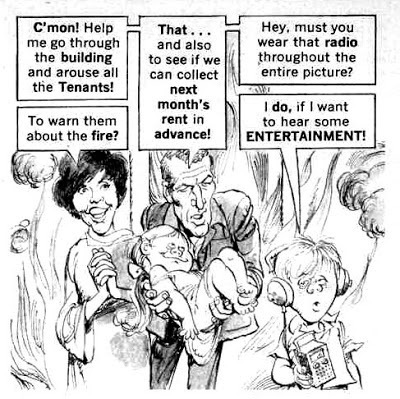 "The Towering Sterno," MAD #177, Sept. 1975
"The Towering Sterno," MAD #177, Sept. 1975
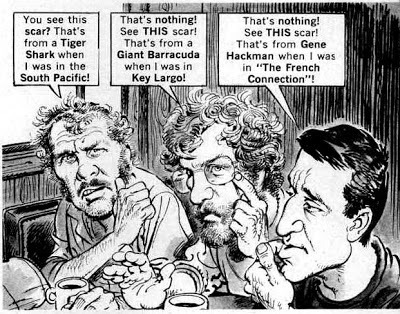
"Jaw'd" in MAD #180, January 1976
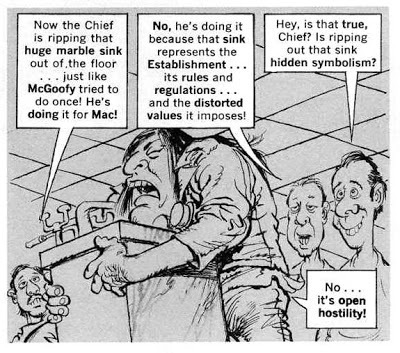 "One Cuckoo Flew Over the Rest" in MAD #184, July 1976
"One Cuckoo Flew Over the Rest" in MAD #184, July 1976
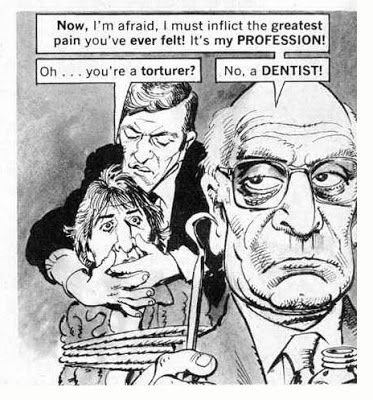 "Marathon Mess" in MAD #191, June 1977
"Marathon Mess" in MAD #191, June 1977
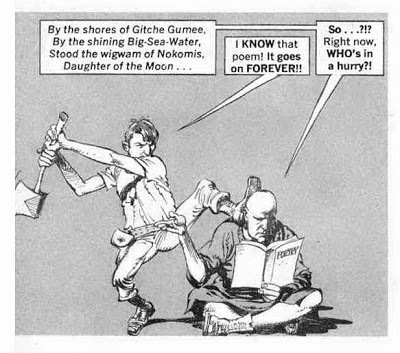 "A Crock O' Blip Now" in MAD #215, June 1980
"A Crock O' Blip Now" in MAD #215, June 1980
Actually, it wasn't until this month I finally did see "Marathon Man" (look for a write-up in the next monthly movie blogpost), but I remembered some of the scenes from "Marathon Mess," which I must've last read at least 30 years ago. And even now, after seeing "Apocalypse Now" dozens of times, my head still fills in the spoof title, "A Crock O' Blip Now," and remember how the "Blip" in the title cleverly blocks out the partially visible word "Shit" on Mort Drucker's double-splash panel. Pretty edgy for the normally profanity-avoiding MADmen.
By the way, not that it needs to be said, but Mort Drucker really is a genius, isn't he? I mean, just look at all those panels above. Each one packed with beautifully drawn caricatures, gorgeous linework and washes, and a real sense of manic energy. Even before I read MAD, I was a CRACKED fan, and I'll always love the precise quality of John Severin's celebrity portraits, but Drucker was operating on a whole other level.
"For many of us, the first exposure to classic films wasn’t on film at all, it was in print. It was in black and white even if the films were in color, it was printed on cheap paper, and it was full of some of the worst puns known to man."Hendrix writes how he first encountered "The Godfather," "Little Big Man" and "2001: A Space Odyssey" in the pages of MAD, where they were reworked and retitled as "The Oddfather," "Little Dull Man" and "201 Minutes of Space Idiocy."
Same here. Even before I was technically owned a copy of MAD, much less bought a ticket for an R-rated movie, I devoured every issue via friends, family and long waits at the grocery store's newsstand. I'm guessing I'm a bit younger than Hendrix, judging by the movies he lists, but I still remember the MAD parodies of some vintage films. In fact, in some cases, I remember them better than the films themselves.
 "The Towering Sterno," MAD #177, Sept. 1975
"The Towering Sterno," MAD #177, Sept. 1975
"Jaw'd" in MAD #180, January 1976
 "One Cuckoo Flew Over the Rest" in MAD #184, July 1976
"One Cuckoo Flew Over the Rest" in MAD #184, July 1976 "Marathon Mess" in MAD #191, June 1977
"Marathon Mess" in MAD #191, June 1977 "A Crock O' Blip Now" in MAD #215, June 1980
"A Crock O' Blip Now" in MAD #215, June 1980Actually, it wasn't until this month I finally did see "Marathon Man" (look for a write-up in the next monthly movie blogpost), but I remembered some of the scenes from "Marathon Mess," which I must've last read at least 30 years ago. And even now, after seeing "Apocalypse Now" dozens of times, my head still fills in the spoof title, "A Crock O' Blip Now," and remember how the "Blip" in the title cleverly blocks out the partially visible word "Shit" on Mort Drucker's double-splash panel. Pretty edgy for the normally profanity-avoiding MADmen.
By the way, not that it needs to be said, but Mort Drucker really is a genius, isn't he? I mean, just look at all those panels above. Each one packed with beautifully drawn caricatures, gorgeous linework and washes, and a real sense of manic energy. Even before I read MAD, I was a CRACKED fan, and I'll always love the precise quality of John Severin's celebrity portraits, but Drucker was operating on a whole other level.
Published on March 24, 2013 14:32
March 18, 2013
Great Moments in Comics History, Part 15
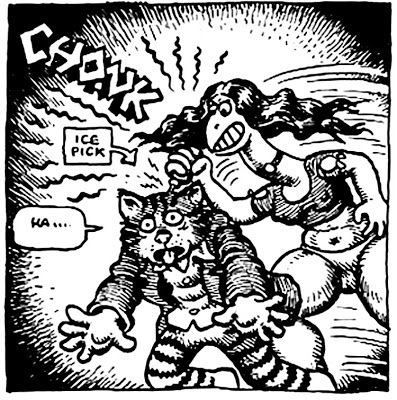
Fritz the Cat's past finally catches up with him.
"Fritz the Cat, Superstar," The People's Comics, 1972; script, art and lettering by Robert Crumb.
Published on March 18, 2013 18:47
March 17, 2013
Great Moments in Comics History, Part 14
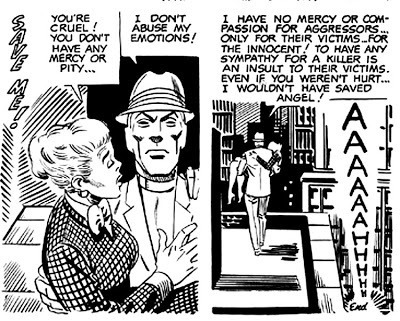
Mr. A talks (and talks) while a guy falls to his death.
"Angel," Witzend #3, 1967; Script, pencils and inks by Steve Ditko.
Published on March 17, 2013 20:20
March 10, 2013
Let us all stand gasping in awe at the majesty of The Sea Bat!
How the hell did this movie slip past my notice?
Released in 1930 by MGM, "The Sea Bat" screened this week on Turner Classic Movies. Intrigued by the description, which said something about Raquel Torres seeking vengeance on a giant sting ray that killed her husband, I set the DVR and forgot about it. I knew Raquel Torres (real name Paula Osterman -- though she was Mexican) from "Duck Soup," so I figured the Marx Brothers connection alone was worth tuning in for. Plus, that whole "giant sting ray" angle sounded interesting. I've seen a lot of movies about giant monsters, but I had to admit, I hadn't seen one of those before. Plus, I was curious to see how the special effects would be handled. 1930, keep in mind, was a year before the horror movie boom began with 1931's "Dracula" and "Frankenstein" and three years before the giant monster classic "King Kong."
So the next day I plopped down on the couch, fired up the remote and was greeted with this...
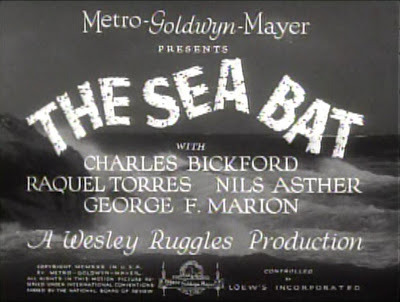
Though his name is big (and italicized!), director Wesley Ruggles was, according to the occasionally reliable Internet Movie Database, replaced during filming by none other than the great Lionel Barrymore, which by itself makes this movie worth a look. And, I'm happy to say, there are plenty of other reasons to give "The Sea Bat" a look, too.
For one thing, that TCM plot description both barely scratches the surface and is partly wrong. (It's Torres' brother, not her husband, who dies at the fins of The Sea Bat.) I looked for the movie in all my usual reference spots -- Weldon's "Psychotronic" volumes, the various "Forgotten Horrors" books, William Everson's "Classics of the Horror Film," Carlos Clarens' "An Illustrated History of the Horror Film," even Phil Hardy's massive "Encyclopedia of Horror Movies" -- and I got nothing. Leonard Maltin did have this to say, giving the movie two stars:
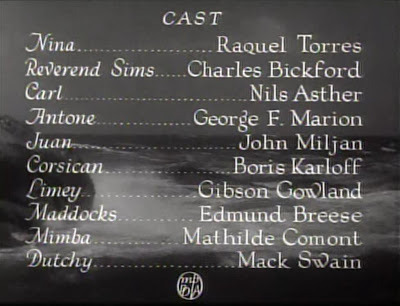
That's right, sixth-billed and playing "Corsican" (which is probably his nationality -- I don't think the character is ever named) is none other than Boris Karloff himself, one year before he became so famous that he was either billed by his last name alone or, even more enigmatically, as "?" (Don't believe me? Click here.) Truth be told, Karloff, like most of the cast, doesn't have a whole lot to do, but he does manage to scowl menacingly when the occasion calls for it...
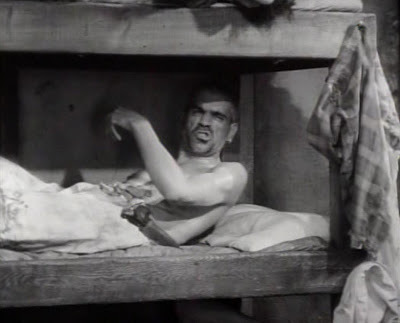
After those credits, we get a couple of interesting text cards setting up the story. (This was at the dawn of sound film, remember, when movies relied on audiences being able to read more than they do now.) An admittedly far-fetched tale is given credibility via National Geographic:
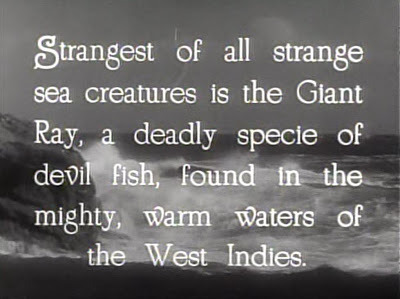
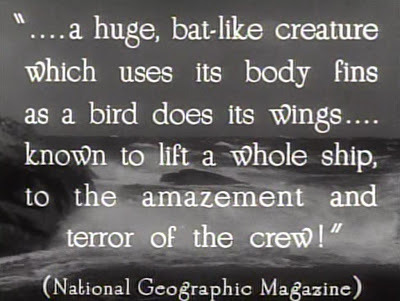
I realize the great thing about science is that it evolves over the years as more knowledge is acquired, but even way back in 1930 did the respected scholars over at National Geographic really believe that the manta ray was a "devil fish" and a "huge, bat-like creature" that was "known to lift a whole ship"? I call shenanigans on this bit of background info, but I love how they tried to convince Depression-era audiences that the hokum (thanks, Leonard) they were about to spring on them was genuine.
Okay, enough foreplay. Let's get to The Sea Bat himself. He arrives near the beginning, when Raquel's doomed brother dives down in search of those sweet, sweet sponges. Even before the monster makes his appearance, the diving scenes are fascinating as a historical artifact. No special effects here, friends. Those are real guys in antique diving suits, and I'm guessing getting those shots was a dangerous undertaking all by itself. This is a long time before scuba tanks were invented, remember...
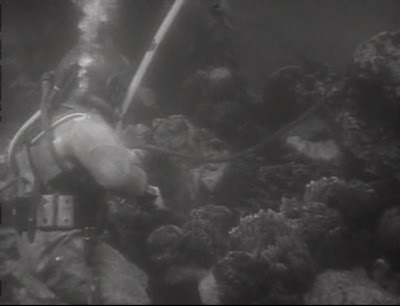
But actual danger or not, the cinematic danger arrives in the form of The Sea Bat. According to the always reliable Wikipedia, manta rays can reach a width of 23 feet, which means that, size-wise at least, "The Sea Bat" is within spitting distance of the realm of possibility. But as far as everything else about a manta ray...
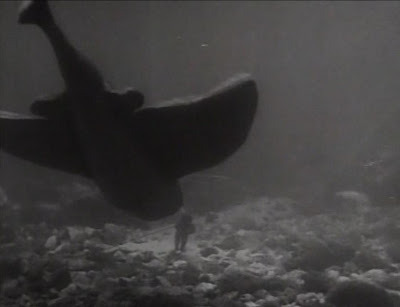
... I remain skeptical about the producers' commitment to verisimilitude. For instance, as seen in the above image, the Sea Bat (shown descending on Raquel's poor, non-voodoo-believing brother) seems a bit thicker than any ray I've ever seen. And I think it has a few extra fins as well.
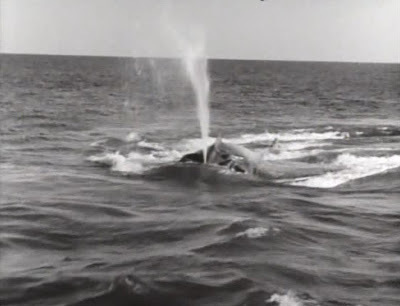
But that's nothing compared to the scenes of the great beast charging along the surface of the water. As you can see, this non-mammal fish like creature has somehow, against all odds, managed to acquire a blowhole. Also, it has somehow acquired both the ability and the desire to charge along the surface of the water. Oh, National Geographic, how could you lend your name to such zoological nonsense?
All complaints about accuracy and blowholes aside, The Sea Bat is a genuinely impressive creation. A few of the shots are miniatures (like that one above of the beast descending on the diver), but in most of the scenes, The Sea Bat is a full-size effect, either pulled by a boat or driven by a motor underneath. Believe me, it's at least as convincing as the shark in "Jaws" (released 44 years later). What's more, the scenes of The Sea Bat pursuing a small boat at the end were, like "Jaws," shot on open water, which gives the movie a nice sense of scale.
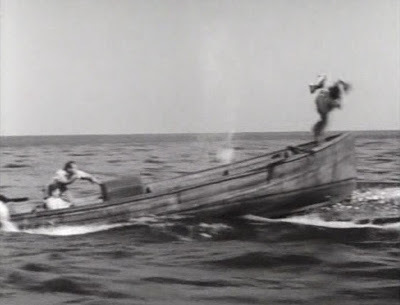
In the shot above, The Sea Bat is pushing the boat containing our hero (Bickford) and the villain trying to turn him in for the reward (which, in most other movies, would make him the hero). It's not exactly a state-of-the-art effect in 2013, but the fact that something actual-sized is about to flip an actual boat makes the moment more effective than it has any right to be.
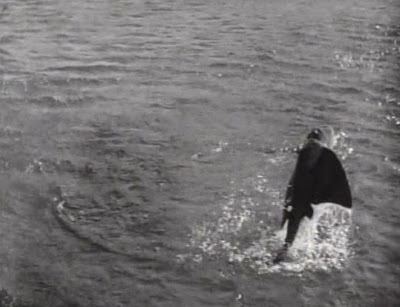
That sense of scale gets thrown out the window moments later when The Sea Bat exits, its mission accomplished and the hero free to romance Raquel Torres once again. Still, the image of this strangely shaped beast flying above the waves for a moment of glorious triumph is so wonderfully implausible (make that impossible) that any fan of monster movies or special effects is bound to appreciate it. After all he's done (kill three people, one good and two bad), The Sea Beast has earned his literal moment in the sun.
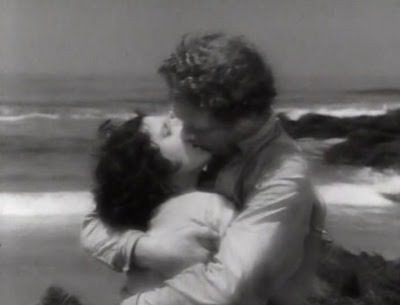
After that, all that's left for the movie is to return Charles Bickford to the loving arms of Raquel Torres for the final fade out. Not a bad ending, and a surprisingly upbeat one (even though the reformed Bickford decides to return to Devil's Island to serve the rest of his sentence). But there's a reason the movie isn't called "The Fake Priest and the Island Girl." If this forgotten movie is worth remembering 80-plus years later, it's not because of them. It's because of The Sea Beast.
Released in 1930 by MGM, "The Sea Bat" screened this week on Turner Classic Movies. Intrigued by the description, which said something about Raquel Torres seeking vengeance on a giant sting ray that killed her husband, I set the DVR and forgot about it. I knew Raquel Torres (real name Paula Osterman -- though she was Mexican) from "Duck Soup," so I figured the Marx Brothers connection alone was worth tuning in for. Plus, that whole "giant sting ray" angle sounded interesting. I've seen a lot of movies about giant monsters, but I had to admit, I hadn't seen one of those before. Plus, I was curious to see how the special effects would be handled. 1930, keep in mind, was a year before the horror movie boom began with 1931's "Dracula" and "Frankenstein" and three years before the giant monster classic "King Kong."
So the next day I plopped down on the couch, fired up the remote and was greeted with this...

Though his name is big (and italicized!), director Wesley Ruggles was, according to the occasionally reliable Internet Movie Database, replaced during filming by none other than the great Lionel Barrymore, which by itself makes this movie worth a look. And, I'm happy to say, there are plenty of other reasons to give "The Sea Bat" a look, too.
For one thing, that TCM plot description both barely scratches the surface and is partly wrong. (It's Torres' brother, not her husband, who dies at the fins of The Sea Bat.) I looked for the movie in all my usual reference spots -- Weldon's "Psychotronic" volumes, the various "Forgotten Horrors" books, William Everson's "Classics of the Horror Film," Carlos Clarens' "An Illustrated History of the Horror Film," even Phil Hardy's massive "Encyclopedia of Horror Movies" -- and I got nothing. Leonard Maltin did have this to say, giving the movie two stars:
"Primitive potboiler about an escaped convict (Bickford) posing as a priest, falling for island vamp Torres and getting involved with pagan voodoo charms and rival sponge divers who are trying to capture a deadly stingray. Ripe hokum sparked by vividly shot action scenes."At least Leonard (or whatever intern he assigned to watch "The Sea Bat") got most of the plot right. Bickford is the biggest presence (and best actor) in this film, playing a Devil's Island escapee hiding behind a bible and a collar. And the whole plot does revolve around, of all things, sponge diving. That's what gets the heroine's brother into the water (he laughingly rejects the voodoo protection charm she offers him, saying his cross will keep him safe. Spoiler alert: It doesn't.) But I'm getting ahead of myself. Besides the titular Sea Bat, Lionel Barrymore behind the cameras and the undeniable charms of a pre-"Duck Soup" Raquel Torres, the cast also boasts another big name... before he became a big name:

That's right, sixth-billed and playing "Corsican" (which is probably his nationality -- I don't think the character is ever named) is none other than Boris Karloff himself, one year before he became so famous that he was either billed by his last name alone or, even more enigmatically, as "?" (Don't believe me? Click here.) Truth be told, Karloff, like most of the cast, doesn't have a whole lot to do, but he does manage to scowl menacingly when the occasion calls for it...

After those credits, we get a couple of interesting text cards setting up the story. (This was at the dawn of sound film, remember, when movies relied on audiences being able to read more than they do now.) An admittedly far-fetched tale is given credibility via National Geographic:


I realize the great thing about science is that it evolves over the years as more knowledge is acquired, but even way back in 1930 did the respected scholars over at National Geographic really believe that the manta ray was a "devil fish" and a "huge, bat-like creature" that was "known to lift a whole ship"? I call shenanigans on this bit of background info, but I love how they tried to convince Depression-era audiences that the hokum (thanks, Leonard) they were about to spring on them was genuine.
Okay, enough foreplay. Let's get to The Sea Bat himself. He arrives near the beginning, when Raquel's doomed brother dives down in search of those sweet, sweet sponges. Even before the monster makes his appearance, the diving scenes are fascinating as a historical artifact. No special effects here, friends. Those are real guys in antique diving suits, and I'm guessing getting those shots was a dangerous undertaking all by itself. This is a long time before scuba tanks were invented, remember...

But actual danger or not, the cinematic danger arrives in the form of The Sea Bat. According to the always reliable Wikipedia, manta rays can reach a width of 23 feet, which means that, size-wise at least, "The Sea Bat" is within spitting distance of the realm of possibility. But as far as everything else about a manta ray...

... I remain skeptical about the producers' commitment to verisimilitude. For instance, as seen in the above image, the Sea Bat (shown descending on Raquel's poor, non-voodoo-believing brother) seems a bit thicker than any ray I've ever seen. And I think it has a few extra fins as well.

But that's nothing compared to the scenes of the great beast charging along the surface of the water. As you can see, this non-mammal fish like creature has somehow, against all odds, managed to acquire a blowhole. Also, it has somehow acquired both the ability and the desire to charge along the surface of the water. Oh, National Geographic, how could you lend your name to such zoological nonsense?
All complaints about accuracy and blowholes aside, The Sea Bat is a genuinely impressive creation. A few of the shots are miniatures (like that one above of the beast descending on the diver), but in most of the scenes, The Sea Bat is a full-size effect, either pulled by a boat or driven by a motor underneath. Believe me, it's at least as convincing as the shark in "Jaws" (released 44 years later). What's more, the scenes of The Sea Bat pursuing a small boat at the end were, like "Jaws," shot on open water, which gives the movie a nice sense of scale.

In the shot above, The Sea Bat is pushing the boat containing our hero (Bickford) and the villain trying to turn him in for the reward (which, in most other movies, would make him the hero). It's not exactly a state-of-the-art effect in 2013, but the fact that something actual-sized is about to flip an actual boat makes the moment more effective than it has any right to be.

That sense of scale gets thrown out the window moments later when The Sea Bat exits, its mission accomplished and the hero free to romance Raquel Torres once again. Still, the image of this strangely shaped beast flying above the waves for a moment of glorious triumph is so wonderfully implausible (make that impossible) that any fan of monster movies or special effects is bound to appreciate it. After all he's done (kill three people, one good and two bad), The Sea Beast has earned his literal moment in the sun.

After that, all that's left for the movie is to return Charles Bickford to the loving arms of Raquel Torres for the final fade out. Not a bad ending, and a surprisingly upbeat one (even though the reformed Bickford decides to return to Devil's Island to serve the rest of his sentence). But there's a reason the movie isn't called "The Fake Priest and the Island Girl." If this forgotten movie is worth remembering 80-plus years later, it's not because of them. It's because of The Sea Beast.
Published on March 10, 2013 14:13
March 9, 2013
Great Moments in Comics History, Part 13
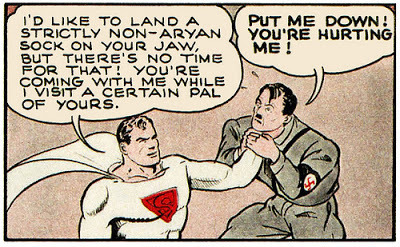
Superman passes up his chance to kill Hitler in early 1940.
"How Superman Would End the War," Look Magazine, Feb. 27, 1940; script by Jerry Siegel, art by Joe Shuster
Published on March 09, 2013 13:51
March 5, 2013
Movies I Watched in Feburary, Part 2
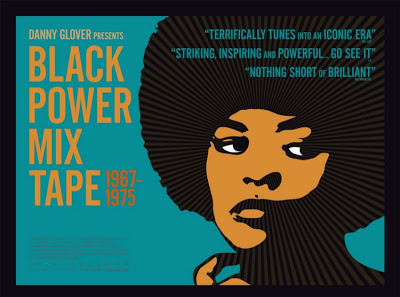
Interesting slice of history culled from several years' worth of footage of the U.S. Black Power movement shot by Swedish documentary filmmakers. Not so much a documentary as a moving collage of an era, with guest appearances by such luminaries as Stokely Carmichael, Martin Luther King, Malcolm X and Angela Davis -- plus lots of average folks, whose ground-level perspective on the often shocking events of the day proves fascinating now, when things have changed both completely and not at all.
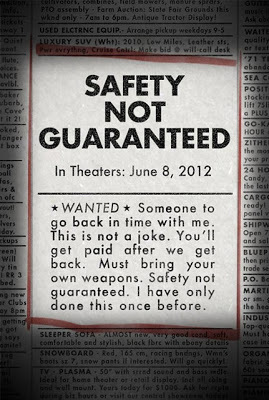
When the above ad is spotted by the crew of a hip alternative magazine (do they make those anymore?), a cynical tail-chasing reporter (Jake Johnson) takes a pair of interns (Aubrey Plaza of "Parks and Rec" and Karan Soni) to track down the fellow (Mark Duplass) who posted it to see what his deal could possibly be. Naturally, the cynic finds his heart, Plaza falls in love with Duplass and the other guy gets laid. It sounds like a Mad Libs for a Quirky Indie Film, and it sort of is, but it's still entertaining and, sue me, it won me over. The cast is game, the premise is offbeat and it's all put together in a nicely low-key way.
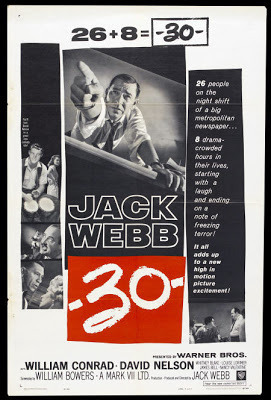
One of my favorite newspaper movies -- and hell, one of my favorite movies in general, despite -- nay, because of the fact that it's corny, far-fetched and about as subtle as a brick to the head. Jack Webb leads a newsroom of capital-C characters, including crusty William Conrad, bongo-playing David Nelson and grouchy Richard Deacon. What makes this movie work for me -- and trust me, it really does work -- is that during the single night covered in "-30-," we never leave the newsroom. All the big stories -- a military jet test, a kid trapped in a storm drain, etc. -- are shown through the eyes of the staff. I left the news business last year, and that was decades after it stopped being anything like this, but it still reminded me of what it used to be like to be in a newsroom when news was breaking.
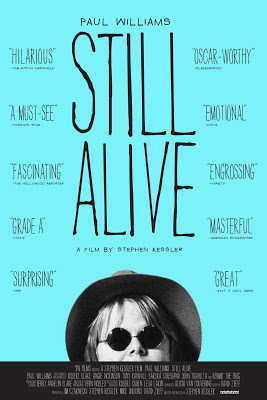
If you're the same age as me (45 -- good lord!), Paul Williams probably played a surprisingly large part in your childhood. He wrote songs like "We've Only Just Begun" and "The Rainbow Connection," appeared in movies like "Smokey and the Bandit" and "Battle for the Planet of the Apes" and guest-starred in every show on the air, from "The Love Boat" to "The Muppet Show" to "Fantasy Island." This documentary charts writer/director Steven Kessler's attempt to figure out what the heck happened to the once-ubiquitous Williams. (Long story short: He took a lot of drugs, then turned his life around.) Kessler gets annoying at times, but Williams remains a fun, fascinating figure. Best of all, the vintage clips are great, offering a nostalgic blast back to the 1970s era of talk shows and guest spots. Like music, movies or pop culture? (I'm guessing you do.) Then check this one out.
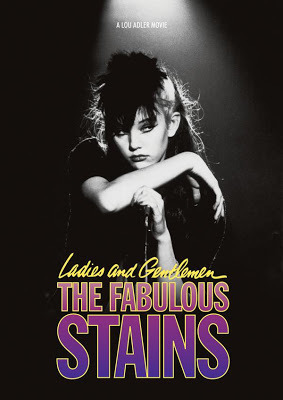
Finally caught up with this semi-legendary cult film about a teen punk band (led by a shockingly young Diane Lane) and its rise and fall over a period of what seems like a week or two. It's sloppy and ragtag, but that fits the story of the Stains (whose music sounds a notch above the Shaggs or a notch below the Vaselines) and their struggles with fame. The band they eventually usurp is led by Ray Winstone (as shockingly thin as Lane is young) and includes two former Sex Pistols and a member of the Clash -- pretty solid lineup if you ask me. Critics slammed the ending, which was filmed years later (Lane and co-star Laura Dern are noticeably older) and turns the Stains into slick, MTV-era stars, but I thought it was brilliant -- it's so slick and so polished that even if it's not an intentional satire of punksters selling out, it works perfectly along those lines.
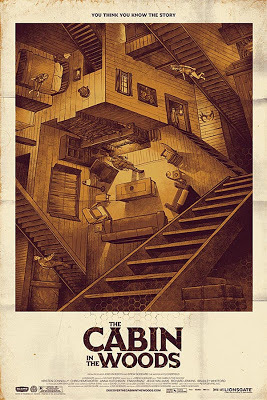
I wrote about this movie before, both in my Best of 2012 post and my September recap, and at neither time did I reveal much about the movie, because this is one experience best enjoyed knowing as little as possible. I'll repeat that strategy here, on the off-chance that someone reading this hasn't had the movie spoiled. I will say this, though: For a movie with such big twists, it's still damned enjoyable the second time around. And, I'm guessing, the third.
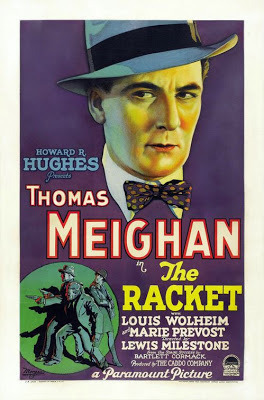
A silent. gangster movie from 1928 that manages to predict many of the cliches of the genre while still spinning a fast-paced, exciting tale. Captain McQuigg (Thomas Meighan) tries to end the criminal reign of the extremely Capone-esque Nick Scarsi (Louis Wolheim), who runs a city that sure seems to be Chicago. Booted out to the sticks by a paid-for politician, McQuigg makes his move, with the help of some cheerfully drunken reporters and a gold-digging dame (Marie Prevost) who has her eyes on Scarsi's innocent kid brother. If you have a chance to catch it on Turner Classic Movies, where it shows up every so often, be sure to take it. Yes, it's silent, but it moves pretty quickly and some of the scenes -- including a gun battle on a colossal street set -- are still impressive more than 80 years later.
Published on March 05, 2013 18:51
March 1, 2013
Movies I Watched in February, Part 1
Short month, but a lot of movies. So many, in fact, that I'm splitting February up into a pair of blog posts. Here's part one...
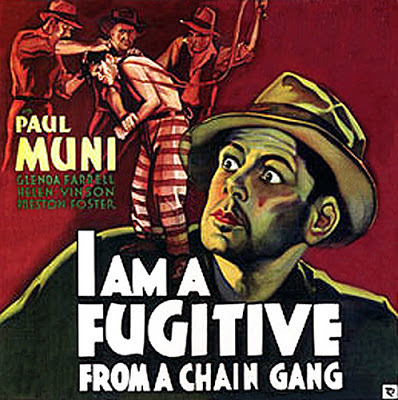
I've seen this movie several times and own the excellent Warner Bros. DVD, but I couldn't help but watch it on TCM as soon as I stumbled across it one night. Damned near hypnotic in its incessantly bleak depiction of a poor guy (Paul Muni) who gets involved in a stickup, gets sentenced to a chain gang and watches his life fall to pieces and his dreams die over and over again. One of the greatest last lines of dialogue in movie history.
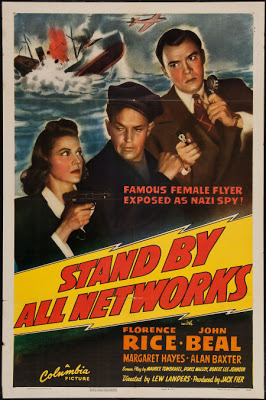
So-so low-budget drama about an intrepid radio reporter (John Beal) who manages to be on the scene of virtually every act of sabotage within a thousand-mile radius. It's fun to see the station manager try to lean on him to quit editorializing only to be proven repeatedly wrong, and the twist of the villain's identity is slightly surprising -- until you realize it was spoiled RIGHT ON THE POSTER.
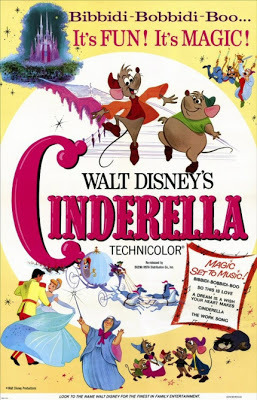
I can't stand this movie, but Allie was feeling nostalgic one afternoon, so into the player it went. Sure, the animation is beautiful and the cruel stepmother is one of the great Disney villains, but seeing Cinderella act like a doormat for the entire movie is just depressing (especially if you're the father of a daughter), and that scene where her stepsisters gleefully rip her dress to shreds looks a lot like a rape scene to these modern, jaded eyes. Give me Mulan any day!
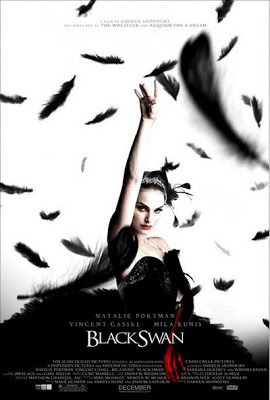
Speaking of fairy tales with questionable female role models... After rewatching "The Wrestler" late last year, I decided to give Darren Aronofsky's ballet horror show another spin, and I remain just as impressed as the first time I saw it. It's a thrilling little nightmare with lots of brilliant, unnerving touches and, like "The Wrestler," I'd argue one that ends perfectly, giving its protagonist the only possible "happy" ending she could get.
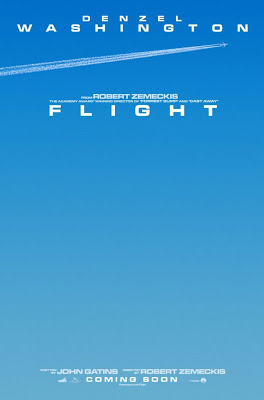
Finally, Robert Zemeckis returns from the wilds of motion capture moviemaking and delivers a film with actual, human characters, a genuinely compelling story and some solid non-CGI acting. Denzel Washington is great as a hotshot pilot whose reckless cravings for coke and booze are related to the insane balls he shows in flipping a plane so he can land it safely. The movie is much more about Washington trying to get his life back in order than get that plane on the ground, but it's still an exciting ride, with plenty to say about recovery, responsibility and personal courage. And, to give the CGI it's due, that plane crash is pretty amazing.
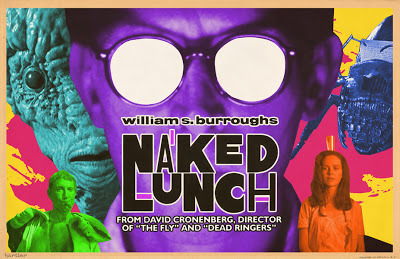
Last time I saw this movie was on a VHS tape (yes, a tape) in the very early 1990s, not long after this David Cronenberg mind-bender quickly zipped in and out of theaters. Back then, I barely knew who William Burroughs was and definitely hadn't read the book this movie is sort-of based on. But now that I'm well versed in the man's twisted works and poring through a detailed biography of him, I figured I'd give the movie another shot, via the excellent Criterion DVD. The verdict? Not as wild as the book ( really, what movie could be?) but still a lot of fun in a downbeat, deadpan way. Peter Weller is excellent as "Bill Lee," and Judy Davis (who had a great run in the early 1990s) is just as good playing his doomed wife and her doppelganger. The late, great Roy Scheider, though, steals the show as Dr. Benway, including a startling last scene that should've made this movie a mall-theater blockbuster. (Sure, sure.)
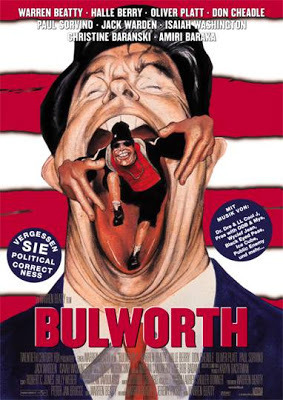
This movie was a star-driven, star-studded would-be blockbuster aimed at your average American audiences, but I'd argue it's at least as strange as "Naked Lunch." Warren Beatty directed, acted in and co-wrote this manic political satire about a suicidal politician who takes a contract out on himself and, thinking he's doomed, feels free to say what he wants to say -- or, in this care, raps what he wants to rap. It's the definition of hit and miss, but even the misses are fascinating, with Beatty dressed in Urban Fashion Circa 1998 and awkwardly hip-hopping his way through the political landscape. Maybe it's my irrational love for Warren Beatty as a moviemaker that lets me overlook this films many shortcomings, but I find the whole mess both fascinating and entertaining. Your mileage though -- and I cannot stress this enough -- may differ.
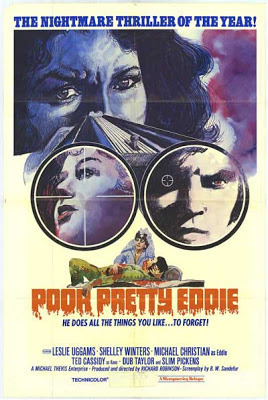
Keeping the theme of "strange movies about awkward race relations," here's a bit of sleazy exploitation from 1975. When singer Leslie Uggams' Rolls breaks down deep in the American South, she winds up at a backwoods resort owned by faded star Shelly Winters and managed by would-be Elvis Michael Christian. From there, things go very wrong, very fast, with Eddie (Christian) taking a real shine to Uggams and not taking "no means no" for an answer. "Poor Pretty Eddie" has that low-budget, scuzzy atmosphere of the best/worst 1970s shockers, and there's palpable tension generated by the simple fact that you have no idea what might happen next. By the way, just to prove moviemakers of the era knew how to get the most bang for their buck, "Poor Pretty Eddie" was also released in select (but very different) markets as "Black Vengeance" and "Redneck County."
Coming up next: Jack Webb, Paul Williams and a very young and surly Diane Lane
Published on March 01, 2013 19:11
February 26, 2013
A fitting tribute to 007
Among the many, many disappointing aspects of Sunday night's Oscar show, the much-hyped tribute to James Bond turned out to be not much at all, after all. It's not like the Bond movies have ever been Oscar-favorites or even Oscar-worthy (whatever that means, quality-wise), but a series that has had such a tremendous impact on pop culture -- and frankly, is so much fun -- deserves better than what the Academy aired, a mishmash of clips and graphics that managed to be both slick and slapdash.
So forget all about that (remember, of course, Shirley Bassey's performance of "Goldfinger") and instead watch this montage created by Kees van Dijkhuizen Jr., which is everything the Academy tribute should have been. I saw it on Slate.com, but it deserves to be seen everywhere.
So forget all about that (remember, of course, Shirley Bassey's performance of "Goldfinger") and instead watch this montage created by Kees van Dijkhuizen Jr., which is everything the Academy tribute should have been. I saw it on Slate.com, but it deserves to be seen everywhere.
Published on February 26, 2013 18:04
February 19, 2013
Great Moments in Comics History, Part 12
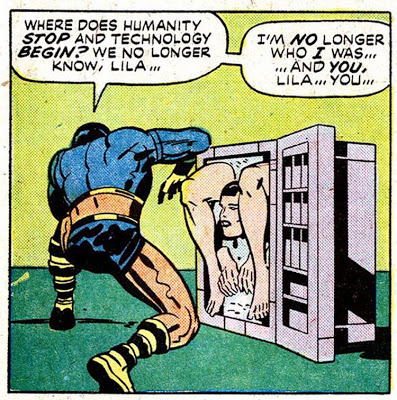
OMAC confronts some harsh truths and asks some big questions.
OMAC #1; Sept.-Oct. 1974; script, pencils and editing by Jack Kirby; inks and letters by Mike Royer
Published on February 19, 2013 17:49
Will Pfeifer's Blog
- Will Pfeifer's profile
- 23 followers
Will Pfeifer isn't a Goodreads Author
(yet),
but they
do have a blog,
so here are some recent posts imported from
their feed.



